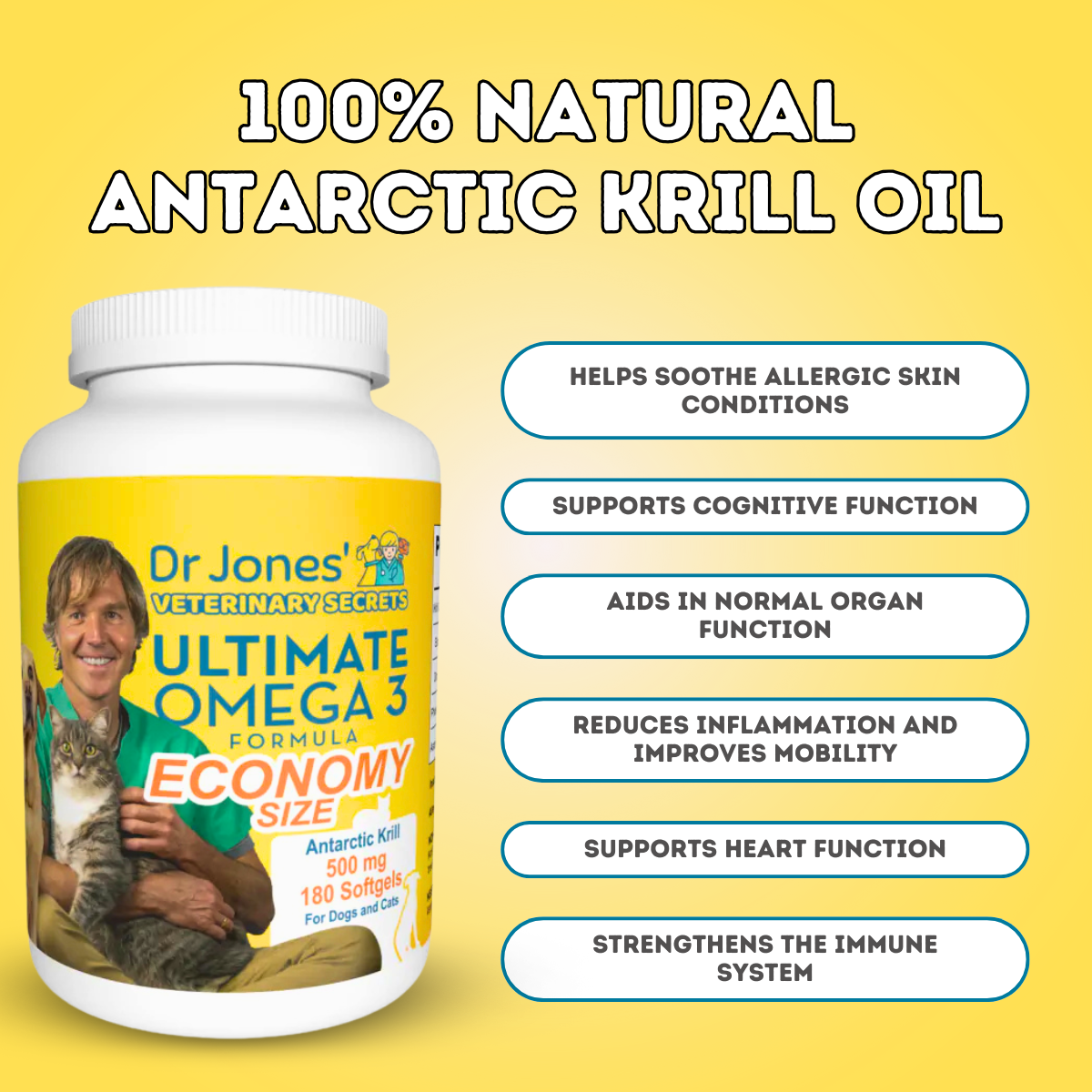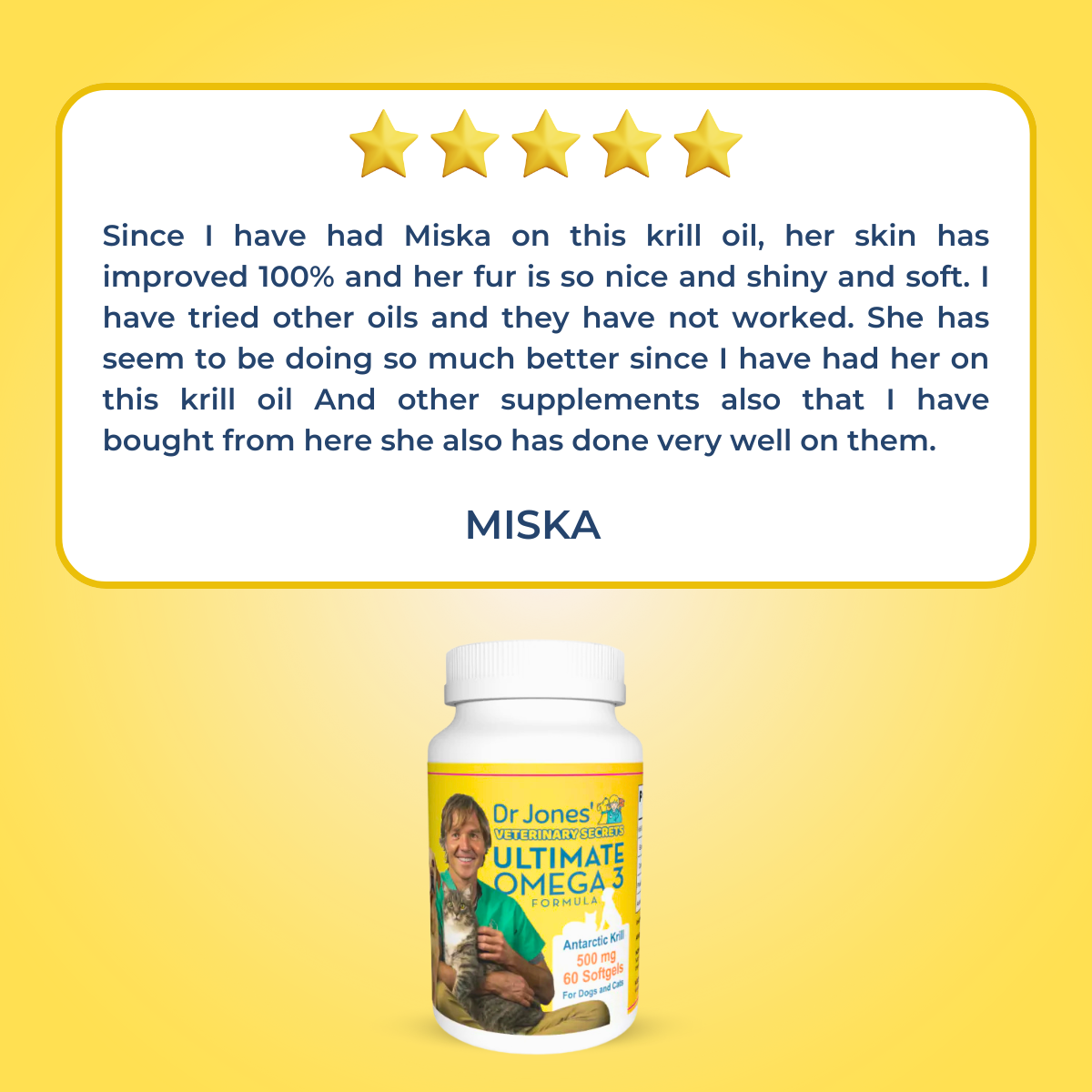To Snip or Not to Snip? What Vets Wish You Knew Before Spaying or Neutering Your Pet
![]()

Can Early Spay/Neuter Really Cause Cancer?
The answer may surprise you: yes, early spaying or neutering can potentially increase the risk of certain cancers in pets. This is one of those longstanding veterinary practices that now deserves some rethinking.
I have spent years learning about the various factors that can contribute to cancer in dogs and cats. These factors include diet, genetics, and environmental toxins. But there is one supplement that every veterinarian agrees on as being beneficial for our pets’ health: Omega 3 Fatty Acids.
The Role of Omega 3 Fatty Acids in Preventing Cancer
Numerous studies have shown that Omega 3 fatty acids can have significant protective effects against cancer. These essential fats help reduce inflammation, support immune function, and may prevent the growth of cancer cells. Whether you’re concerned about your pet’s health now or in the future, adding Omega 3s to their diet is an easy and highly beneficial step.

Dr. Jones’ Ultimate Omega 3 Formula for Dogs and Cats
If you’re looking for a high-quality Omega 3 supplement for your pets, look no further than Dr. Jones’ Ultimate Omega 3 Formula. This formula is 100% natural, full-spectrum, and made with organic Antarctic Krill Oil. It’s rich in EPA, DHA, Phospholipids, and Astaxanthin, all of which work together to promote optimal health and help prevent cancer.

Risks Associated with Spaying and Neutering Your Dog
As a veterinarian, I have traditionally recommended universal spaying and neutering of dogs, ideally by six months of age. This practice was widely encouraged to reduce the stray pet population, prevent reproductive diseases, and lower anesthetic risks associated with early procedures on young puppies.
However, recent studies have started to challenge this approach, revealing both positive and negative impacts of spaying and neutering on four key areas of canine health: weight, urinary tract health, orthopedic disease, and cancer.
Let’s explore these in more detail.
Weight Gain After Spaying and Neutering
One of the most common concerns following spaying or neutering is weight gain. It’s been well documented that spaying and neutering dogs increase the risk of obesity. While other factors, like lack of exercise or excessive calorie intake, play a role, early spay/neuter makes it much easier for dogs to gain weight. This is something to consider when deciding the best time for the procedure.
Urinary Tract Disease in Spayed Dogs
Another issue linked to spaying is an increased risk of urinary tract disease, particularly urinary incontinence. Studies suggest that between 5% and 20% of spayed dogs develop this condition. Larger dogs, particularly those over 45 pounds, are at a higher risk, with incidences ranging from 12% to 31%.
In addition to incontinence, there’s also an elevated risk of urinary tract infections (UTIs). Since incontinence can result in a partially open bladder, it creates an environment where bacteria can easily enter, increasing the likelihood of infection.
For comparison, dogs that are not spayed rarely experience incontinence, with only about 1% of them affected. This raises the question of whether spaying is always beneficial for urinary tract health.
Orthopedic Disease Risk
The risks of orthopedic diseases are most pronounced when dogs are spayed or neutered before reaching skeletal maturity. When growth plates haven’t closed yet, early spaying or neutering can delay their closure, resulting in disproportionately long limbs. This alters the way weight is distributed and the amount of stress on the joints, which increases the risk of orthopedic diseases like cranial cruciate ligament (ACL) ruptures and hip dysplasia.
This risk is particularly high in large and giant breed dogs (those weighing over 50 pounds). These dogs’ growth plates close later than smaller breeds, so I recommend waiting until they reach skeletal maturity—typically between 16 and 24 months of age—before spaying or neutering.
Cancer Risks Linked to Spaying and Neutering
When I was in veterinary school, I was taught that early spaying or neutering eliminated the risks of certain cancers like mammary cancer, testicular tumors, and pyometra. However, recent research has shown that early spaying and neutering may actually increase the risk of some cancers in certain breeds.
Mast cell tumors, hemangiosarcoma, lymphoma, and osteosarcoma have been shown to occur more frequently in spayed and neutered pets. For example, studies have found that Rottweilers spayed before 1 year of age have nearly three times the risk of developing osteosarcoma, and neutered males have nearly four times the risk of developing prostate cancer.
For Golden Retrievers, spaying or neutering at any age has been associated with an increased risk of certain cancers, with the risk increasing by 5% to 15%, depending on the age at which the procedure is done.
What Should You Do?
With all this information, the decision of when to spay or neuter your dog should be based on several factors, including breed, weight, and the dog’s overall health. Here are my general recommendations:
- Small breed dogs (under 30 pounds): Spay or neuter around 6 months, though I personally prefer waiting until 1 year of age for optimal health.
- Large breed dogs (over 50 pounds): Wait until after skeletal maturity—around 16-24 months—for female dogs, or any time after skeletal maturity for male dogs.
- Certain breeds (like Golden Retrievers and Rottweilers): Delay spaying or neutering until at least 24 months.
My Personal Opinion
In my opinion, for most dogs, it’s better to delay spaying or neutering until at least 12 months of age. Allowing them to reach skeletal maturity can help prevent some bone and joint disorders, reduce the chances of incontinence, and lower the risk of cancer.
Personal Experience and Prevention
Having had two of my own dogs succumb to cancer, I take the health of my pets very seriously. To help prevent cancer in my current dog, Tula, I’m giving her a variety of supplements that I believe may help. One of the most effective and studied supplements for cancer prevention is Omega-3 fatty acids. Both Tula and I take Omega-3s daily as part of our routine.
If you’re interested, we offer a high-quality Omega-3 Krill Oil supplement for pets. It’s one of the best-selling and most effective options for cancer prevention, and it’s available through our website.





I had a sheltie. A good size one not the real small ones . We had him neutered around d 6 months old because the breeder along with our vet set this was the norm and best for him. We lost him at the age of 8. It was devastating and broke our hearts. He was one of the smartest, and one of the best dogs we ever had. We got him when my husband retired and they were inseparable. He died of prostate cancer . We spent a lot of time and money keeping him alive but he could no longer urinate on his own. Selfishly we had him catherized a few times searching for a Dr who could help us but could not find one . It tore us apart. The only one other than you was the oncologist who told us to wait to get a dog neutered to avoid this. Ty for letting people no. Most vets still push for early neutering or spaying .
We are sorry for your loss.
I have female full blooded GSD that will be 7 yrs old in April. She never has been bred. No puppies. The vet told me I need to get her spayed or she will develop other health issues. Is that true? Nikkel is her name.
Here’s an answer based on general research:
It’s true that spaying your female German Shepherd (GSD) can help prevent certain health issues. Here’s why:
1. Prevention of Pyometra:
Pyometra is a potentially life-threatening infection of the uterus that often affects older, unspayed females. It occurs due to hormonal changes in the reproductive system, and spaying eliminates the risk entirely.
2. Risk of Mammary Tumors:
Female dogs that aren’t spayed have a higher risk of developing mammary tumors (breast cancer). The earlier you spay her (before her first heat cycle), the lower her risk of developing these tumors later in life. However, spaying her at 7 years old can still reduce her risk compared to not spaying at all.
3. Prevention of Ovarian and Uterine Cancer:
Spaying removes the ovaries and uterus, eliminating the risk of ovarian and uterine cancers, which are more common in older, unspayed females.
4. Behavioral and Health Benefits:
Spaying can also reduce the risk of certain behavioral issues such as aggression, roaming, or attracting male dogs, which can be a challenge with unspayed females. While these issues may not be as prominent in older dogs, they can still be a factor.
Considerations:
Since your dog is already 7 years old, there are additional factors to consider. Older dogs may have a higher risk during surgery, and you should consult with your vet about the best approach. Your vet might recommend pre-surgical blood tests and other precautions to ensure she’s a good candidate for the procedure.
If your dog is otherwise healthy, spaying could provide long-term health benefits and help prevent serious conditions.
does this apply to cats as well?
Yes
Id like to see some info on cats too. Also No one ever talks about the risk of vaccines causing all these different health issues. So im supposed to believe its beneficial to rip out parts of my pet. Why should I trust any of that info when they dont tell us the truth about how harmful vaccines have been. Maybe its the vaccines and their food causing these issues. And not people didnt mutilate their pets. Also more people are talking about this stuff and the past year or so it seems there is alot of talks of horrible reactions to vaccines some even death. But there’s no data to show, no tracking the effects of vaccines. So no one knows the truth that its either getting worse, or we just finally are talking about it.
We do have set of articles for your query:
https://veterinarysecrets.com/?s=risk+of+vaccine
I have a 3.5 pound male yorkie who is 18months old
My vet says he needs the hormones for his bones and muscles.
I also read that in europe they often do nyu neuter dogs as they feel it’s cruel.
What are the risks of not neutering them at all?
is it a bit of a scam??
Benefits of Neutering
Health Protection: Neutering eliminates the risk of testicular cancer and significantly reduces the likelihood of prostate issues, such as benign prostatic hyperplasia and prostatitis, which are more common in unneutered male dogs.
Behavioral Improvements: Neutered dogs often exhibit fewer hormone-driven behaviors, including aggression, territorial marking, and roaming in search of a mate.
Reduced Risk of Overpopulation: Neutering helps prevent accidental litters, contributing to the broader effort to reduce pet overpopulation.
Considerations for Small Breeds
For small breeds like your Yorkie, some studies suggest that delaying neutering until they are fully grown may help avoid potential joint issues. However, the risks associated with remaining intact, such as testicular cancer and certain behavioral problems, should also be weighed.
Vets push for spaying/neuter just for profit… let your pet be in natural way. Try to take your reproductive organs young and see what will happen to your health…Dogs live longer intact and with home made food, not the junk you buy from the stores, it’s pure poison. And even the vaccines, do not overvaccinate I give my dog only the rabies vaccine. Vets keep waiting to vaccinate every single year or every 3 years… is beginning to be proven they are protected for life with just one vaccine. People started to do titer tests to prove immunity because vets kept wanting to vaccinate every single year… they don’t want your pet healthy… health doesn’t profit…
You’re right to question routine spaying, neutering, and repeated vaccinations. As Dr. Jones discusses, early spay/neuter can have health downsides, and many pets may not need repeat vaccines if they’re already immune—titer testing is a good alternative. The goal should be informed, individualized care—not profit-driven protocols. Homemade diets and minimal vaccines can support long-term health when done properly.
Thank you for sharing your thoughts—I completely agree with you. I have a 3-year-old Staffy who is not neutered, and I’m really worried about the risk of testicular cancer. I’m just not sure what I should do. If anyone could offer some advice, I’d really appreciate it, because I’ve been searching everywhere and I still can’t get a clear answer.
Neutering your 3-year-old Staffy would completely eliminate the risk of testicular cancer, but this type of cancer is rare and usually treatable. If your dog doesn’t have undescended testicles (which raises risk), the cancer concern alone may not be urgent. Neutering can also help reduce marking, roaming, and hormone-driven behavior. Since your dog is fully grown, neutering now is a safe option if you’re looking for health or behavior benefits, but it’s not absolutely necessary if he’s healthy and well-managed.
I have a 2 pound yorkie. Full grown she ll be 5 pounds. She is a pap dog and never off leash outside. Why does she need ttt her e rabies shot. And why Will groomers refuse to groom if no rabies shot? A but if a scam to me
Even small indoor-only dogs often legally must have a rabies shot, because many places have laws requiring it for all dogs. Groomers require proof of vaccination to reduce liability (in case of a bite or disease) and protect their business, staff, and other pets. It’s not usually a “scam” but a way to manage risk and comply with legal/public health rules.
I have a nine month old female Morkie. I am so torn as to whether to spay or not this is the first time I’ve had a female. I had a Maltese male that I did neuter and he lived a healthy life for 18 years.
I know there are risks in spaying but I’m trying to weigh the risks of not spaying as well.
It seems to me that there are more risks if I do not spay? Please help define both and which had less risks. My Morkie is an indoor pup that is trained on artificial grass and only goes out in nice weather for some sun. She gets much exercise in the house running around.
Spaying and not spaying have risks, but overall, spaying usually carries fewer long-term health risks—especially for small breeds like Morkies. Spaying prevents serious conditions such as pyometra (uterine infection) and reduces the risk of mammary cancer, though it can slightly increase chances of weight gain or urinary incontinence if done too early. Since your Morkie is an indoor dog, spaying at the right age (around 9–12 months) is generally recommended to help ensure a healthier, safer life.